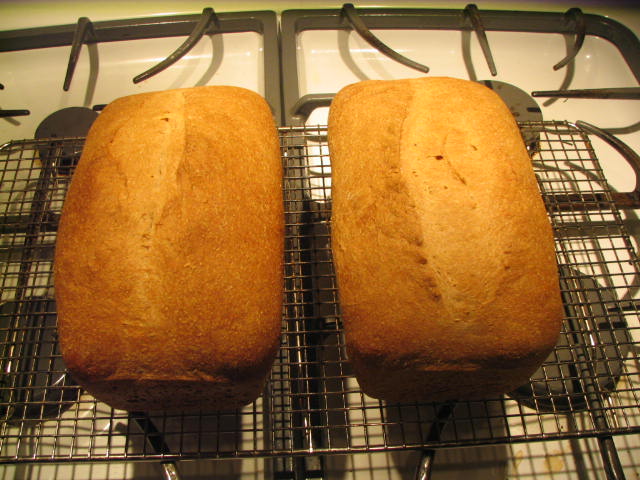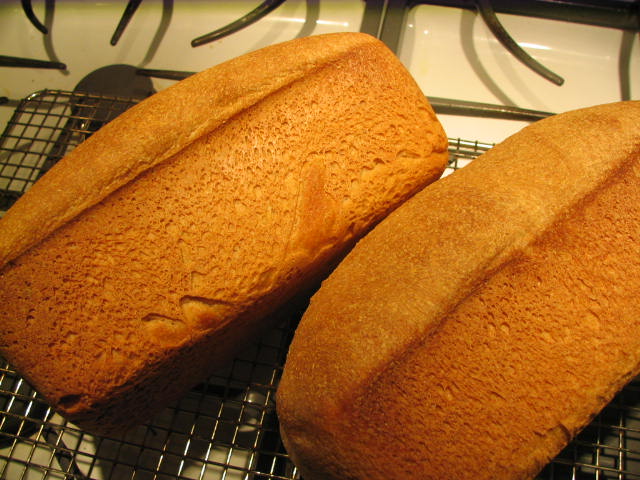So...I baked off the Poilane miche from "Bread Baker's Apprentice". I used my mother starter (which is unbleached white flour). I also used 50/50 water/milk liquid in final dough. A squirt of honey, and a bit of olive oil were my enhancements. The final bread is a about 50/50 whole wheat/unbleached white...a little heavier on the whole wheat. When making the final dough, I mixed firm starter with 4 hour autolyse flour and water/milk. Before adding honey, olive oil, or salt I set aside an amount of dough for firm starter for the next day from the miche dough. Then I added the honey, olive oil, and salt and continued with the kneading, fermentation, shaping, and baking....and simultaneously left the firm starter (dough from recipe) out for about four hours until it almost doubled, then I put it in the refrigerator to use the next day......I've read a couple of times that Poilane mentions that the bakers use dough from the previous day to leaven the bread. The first day I baked the free form miche style (@3 pounds), but I had to use a glass bowl for the shaping that isn't round. The next day, I used the dough (firm starter?) from the previous day, and baked bread loaves. Well, I'm pleasantly surprised with the results.....I would even venture that the dough (firm starter) that I used for the loaves was a bit more energetic...just by feeling. It seems that if one were to bake every day, or every other day that keeping a starter would be redundant???? maybe???? If one always increased their sourdough recipes to have a good portion of firm starter from the dough for the following days, they wouldn't have to keep up with starters/barms??? Any knowledge in this area? I've only been doing sourdough for about 3 weeks, and I'm usually impressed with my starter, but the dough (firm starter?) seemed to be even a smidgeon (scientific term) more energetic. Here are som photos....the free form is starter, and the loaves are dough (firm starter?) from the recipe the day before. 




I just learning how to download the photos, but the free form miche photos should have been first since this was the loaf I baked the first day. I enhanced this recipe with milk, honey, and olive oil because even though my first all whole wheat miche was a success, I wasn't so excited with just the whole wheat standing on it's own. I share most my bread with co-workers, and they usually make sandwiches with whatever bread I bring.
rainwater,
First, your breads turned out great! I don't know how they could look any better. The thing we can't tell from here is the depth of flavor. The use of old dough from the previous day is a method designed to bring forward an advanced progression of fermentation and the bacteria that create the flavors. Since the old dough also has salt added, the yeast is said to be somewhat slowed down in that part of the dough. Your pan loaves look pretty good to me.
From a balance standpoint, you need to keep in mind the additional salt in the old dough and reduce the amount that gets added to the dough.
As you say if you made the same bread every day and kept a firm starter it amounts to the same thing less the salt. I have a video of Professor Calvel showing the use of the old dough method. In it he uses 30% of the total dough weigh as old dough. It's not a small thing he is introducing. This method also works for yeast risen dough and is very effective. One of the best breads I make is an Italian with a Biga that is aged 14-16 hours. The flavor is wonderful and it comes from aging the Biga.
Rainwater, of all the things I have learned about making good bread the most important is that I need to respect the effect of time and temperature on flavor. In the end I think any basic recipe will be made better by introducing an opportunity for the sugars to be broken down and consumed by the bacteria. Autolyse, soakers, old dough and all the preferments do this.
Keep up the good work. What's next for you?
Eric
Actually, ehanner, i put my "next day dough" aside before adding salt, honey, or oil. So, my next day dough is different in only that it has milk in it from mixing with the "autolyse" to form the final dough. I could be corrected, but I thought I had read it mentioned that Professor Calvel autolysed with only flour and liquid (in my case, 50/50, water/milk). I'm playing with this milk in the starter....so far, I like it. I may experiment with my permanent starter by feeding with 50/50, whole wheat/unbleached bread flour....and also using 50/50 water/milk for the starter. I've been pleasantly surprised with the chemistry of milk and starter. Today, I fed my starter normally with water and unbleached bread flour....but I'm going to less hydration......I'm trying 65% hydration, since this is about where my bread dough lives......I could skip the step of making a "firm starter", and just go directly from the "mother bucket" (I keep @3 pounds) to mixing my starter with the autolyse! ! ! These loaves used a 4 hour autolyse, but I'm leaning towards an overnight autolyse????? Do you have any opinion on autolyse time?....I only put liquid and flour at about 65% hydration.
Where am I going from here? I'm just about where I want to be with my bread dough.....I'm fine tuning with the autolyse and starter......
I'm spending a lot of time trying to perfect my pizza dough....if I sent photos, you would say, "wow! those pizzas look good!"....bubbly and delicious looking they are....but I'm not happy with the bite and the texture.....I've had a couple of lucky flukes....but I don't have the pizza dough timing and feel yet!
So far, it seems like sourdough for bread, and yeast for pizza......for right now, these two quests have my full attention......once I've nailed the formula for bread-the starter/autolyse/amounts, which will be soon.....I'll persist with the pizza, and venture into some artisanal loaves......I really favor bread loaf, but I know my co-workers would jump for some ciabatta, foccacia, or some french/italian style baguettes. For now, I don't want to spread myself too thin.....
As far as the flavor you miss in the photo.....I'm very happy with my bread recipe so far......I would say that my bread is slightly springy, but moist.....some nice layers of flavor......good bite and chew......and to go against the current....I actually like the softer crust of the bread loaves versus the free standing loaf. The top crust of the loaves is crisp, but that baked inside the pan is softer. I don't get the gymnastics to create crust.....I don't do anything but throw my free standing loaf on the pizza stone, and it gets plenty crusty....no spraying, no water pans......plus, on everyday after the first day, I toast one side of my bread and this brings the crust back everytime..
Bread is good, pizza needs fine tuning.....